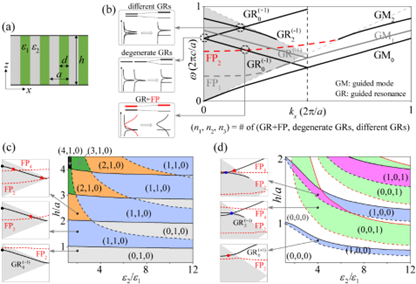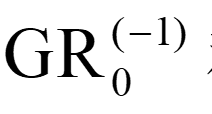On December 1st, 2022, the research group of Prof. Han Dezhuan at Chongqing University, collaborated with the research group of Prof. Jian Zi and Lei Shi at Fudan University, and Profs. C. T. Chan and Z. Q. Zhang at Hong Kong University of Science and Technology published a research article entitled “Global Phase Diagram of Bound States in the Continuum” in Optica, a top journal in optics.
Bound states in the continuum (BICs) are a special class of resonant states. Although they have the same momentum and energy as the propagating modes in free space, they are not coupled to the latter and thus have infinite lifetimes. This unique property has attracted great research interest. Photonic-crystal (PhC) slab is an ideal platform for the study of BICs. According to their formation mechanism, BICs in PhC slab have been conventionally classified into three types: accidental, symmetry-protected and Friedrich-Wintgen BICs. In this work, by treating Fabry-Pérot (FP) and guide resonance (GR) modes on equal footing, the authors found that the accidental BIC originates from the destructive interference between the GR and FP modes; the symmetry-protected BIC stems from the coupling of degenerate GR modes; the conventional Friedrich-Wintgen BIC comes from the coupling of different GR modes. Hence, all these three types of BICs can be classified by the three different Friedrich-Wintgen origins.
Based on the above universal classification, a global phase diagram of BICs can be obtained with each phase identified by the indexes of the three different Friedrich-Wintgen-type BICs, and their evolution in momentum space can be revealed using a phase diagram. As system parameters change, the BICs resulting from the coupling of the GR and FP modes move along with the movement of FP mode. They can merge with the BICs of the same type or the symmetry-protected BIC at G point, or with the BICs resulting from the coupling of two different GR modes at off-G point. It is shown that the FP mode plays a significant role during these merging process. The evolution of an accidental BIC and the merging process of it and a conventional Friedrich-Wintgen BIC at an off-G point are further experimentally observed.
This work reveals the universal behavior of BICs in PhC slabs, and proposes a global phase diagram of BICs to study their evolution, which can provide guidance for the experimental designs and practical applications. Chongqing University is the affiliation of the first author (Dr. Peng Hu) and a corresponding author (Prof. Dezhuan Han). Mr. Jiajun Wang, a PhD student of Fudan University, is the co-first author. Profs. Lei Shi and Jian Zi at Fudan University are the co-corresponding authors. This work was supported by the National Natural Science Foundation of China (grant nos. 12074049, 11727811, 12047564), by RGC Hong Kong (AoE/P-502/20) and by the Croucher Foundation (CAS20SC01).
Link to original article: https://doi.org/10.1364/OPTICA.466190

Figure. Global phase diagrams of BICs in a PhC slab. (a) Schematic diagram of the PhC slab. (b) Schematic diagram of the band structure of PhC slab. The three insets show the diagrams of Friedrich-Wintgen BICs from three different origins: GR+FP modes, degenerate GR modes and two different GR modes. (c) and (d) Phase diagrams of BICs on
and  bands for TE polarization, respectively.
bands for TE polarization, respectively.